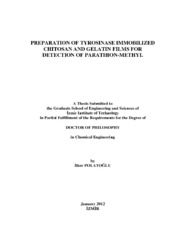Please use this identifier to cite or link to this item:
https://hdl.handle.net/11147/2905Full metadata record
| DC Field | Value | Language |
|---|---|---|
| dc.contributor.advisor | Çakıcıoğlu Özkan, Seher Fehime | en |
| dc.contributor.author | Polatoğlu, İlker | - |
| dc.date.accessioned | 2014-07-22T13:48:35Z | - |
| dc.date.available | 2014-07-22T13:48:35Z | - |
| dc.date.issued | 2012 | en |
| dc.identifier.uri | http://hdl.handle.net/11147/2905 | - |
| dc.description | Thesis (Doctoral)--Izmir Institute Of Technology, Chemical Engineering, Izmir, 2012 | en |
| dc.description | Includes bibliographical references (leaves: 81-87) | en |
| dc.description | Text in English; Abstract: Turkish and English | en |
| dc.description | xi, 94 leaves | en |
| dc.description | Full text release delayed at author's request until 2015.02.09 | en |
| dc.description.abstract | In this work, tyrosinase immobilized chitosan and gelatin films as optical enzyme sensors which were characterized and optimized by UV spectrophotometer, were developed for detection of the pesticide parathion-methyl. The results show that the best sensor was the chitosan supported ones (TCA) prepared by adsorption method due to higher responsiveness and higher catalytic activity. The prepared sensors used for 10 times without significant loss in activity indicate good operational stability. Immobilization of the enzyme to chitosan support increases the pH, temperature and storage stability with respect to free enzyme due to providing structural rigidity and appropriate flexibility by immobilization. The other indication is that, isopropyl alcohol is the most appropriate organic solvent to solve the pesticide due to showing higher solubility for parathion-methyl and lowest inhibition (decrease in activity) for the enzyme. TCA has wide linear detection range and it can detect the parathion methyl concentration below the Maximum Residue Limit (MRL). The decrease in enzyme activity was obtained up to 10 mg/l (ppm) parathion-methyl concentration. The other result is that, kinetics of the immobilized enzyme was reaction controlled for higher substrate concentrations as understood from effectiveness factor, η. Atomic force microscopy (AFM) and FTIR analysis show that tyrosinase enzyme was successfully coated on the surface of chitosan and gelatin films. After using the optical enzyme sensor the binding of product o-quinone to chitosan and gelatin films were observed which was characterized by AFM results and the UV visible absorption peaks. | en |
| dc.language.iso | en | en_US |
| dc.publisher | Izmir Institute of Technology | en |
| dc.rights | info:eu-repo/semantics/openAccess | en_US |
| dc.subject.lcsh | Enzymes | en |
| dc.subject.lcsh | Immobilized enzymes | en |
| dc.subject.lcsh | Pesticides--Analysis | en |
| dc.title | Preparation of tyrosinase immobilized chitosan and gelatin films for detection of parathion-methyl | en_US |
| dc.type | Doctoral Thesis | en_US |
| dc.institutionauthor | Polatoğlu, İlker | - |
| dc.department | Thesis (Doctoral)--İzmir Institute of Technology, Chemical Engineering | en_US |
| dc.relation.publicationcategory | Tez | en_US |
| item.languageiso639-1 | en | - |
| item.fulltext | With Fulltext | - |
| item.openairecristype | http://purl.org/coar/resource_type/c_18cf | - |
| item.openairetype | Doctoral Thesis | - |
| item.grantfulltext | open | - |
| item.cerifentitytype | Publications | - |
| Appears in Collections: | Phd Degree / Doktora | |
Files in This Item:
| File | Description | Size | Format | |
|---|---|---|---|---|
| 423450.pdf | DoctoralThesis | 2.58 MB | Adobe PDF |  View/Open |
CORE Recommender
Page view(s)
158
checked on Jul 22, 2024
Download(s)
78
checked on Jul 22, 2024
Google ScholarTM
Check
Items in GCRIS Repository are protected by copyright, with all rights reserved, unless otherwise indicated.